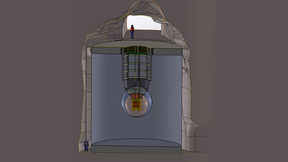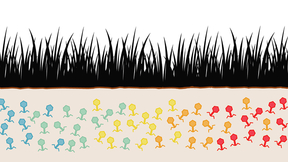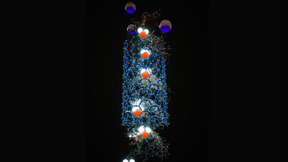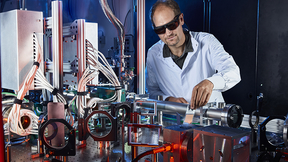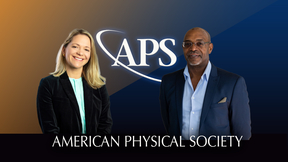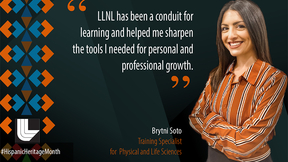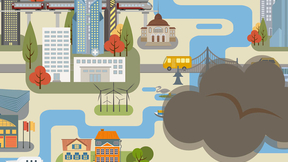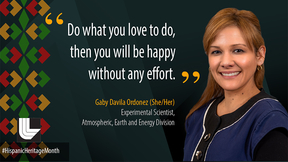Back
Lawrence Livermore National Laboratory (LLNL) has received $2.35 million from the Inflation Reduction Act, which aims to support domestic energy production and promote clean energy and to provide the Department of Energy (DOE) national laboratories with resources to keep the U.S. at the forefront of scientific discovery. The funding has been allocated for the Lab-led nEXO…
Soils contain diverse communities of microorganisms, including bacteria, fungi, protists and viruses. Interactions between these tiny organisms shape the ability of soils to store carbon underground. However, not much is known about the spatial patterns and dynamics of viral communities in soil. New research by Lawrence Livermore National Laboratory (LLNL) scientists and…
Transforming the way energy is collected, stored and used has become a defining challenge of the 21st century. To address this task, the Department of Energy’s (DOE) Office of Basic Energy Sciences (BES) established the Energy Frontier Research Center (EFRC) program. This year, Lawrence Livermore National Laboratory and collaborators were awarded three projects. The first…
A five-year microbial study of the International Space Station (ISS) and its astronauts by Lawrence Livermore National Laboratory (LLNL) and NASA researchers has found that the ISS habitat is safe for its residents. The research effort represents the first comprehensive characterization of the space station’s environmental profile (or microbiome) and is the first to…
Lawrence Livermore National Laboratory (LLNL) scientists are scaling up the production of vertically aligned single-walled carbon nanotubes (SWCNT) that could revolutionize diverse commercial products ranging from rechargeable batteries, automotive parts and sporting goods to boat hulls and water filters. The research appears in the journal Carbon. Most CNT production…
California native Kerianne Pruett started at LLNL in 2019 as an intern, and now works as a spacecraft systems engineer, matrixed to the Physics Division. At the Laboratory, Pruett utilizes data science, machine learning, and high-performance computing to answer questions about dark matter, dark energy, and space domain awareness.
Electromagnetic vortices occur naturally throughout the universe and have recently been observed in association with black holes. Over the last decade, scientists have sought methods to investigate how extremely strong electromagnetic vortices interact with matter, specifically plasma, in a laboratory setting. Plasma, known as the “fourth state of matter,” makes up nearly…
The United Nations (UN) Intergovernmental Panel on Climate Change (IPCC) was jointly awarded the Gulbenkian Prize for Humanity, alongside the Intergovernmental Science-Policy Platform on Biodiversity and Ecosystem Services (IPBES). The prize jury distinguished the two intergovernmental organizations for their role in developing scientific knowledge, alerting society and…
Two Lawrence Livermore National Laboratory (LLNL) scientists have been selected as 2022 fellows of the American Physical Society (APS). Physicists Andrea (Annie) Kritcher and Ronnie Shepherd were both selected by the APS Division of Plasma Physics. APS fellowships are awarded after extensive review and are considered a distinct honor because the evaluation process,…
Safe, long-cycle-life batteries with high energy density are greatly needed with the rapid growth of electric devices and vehicles and grid energy storage demands. Lawrence Livermore National Laboratory (LLNL) scientists have devised a method for the fabrication of all-solid-state lithium metal batteries, which have been recognized as the future choice of safe and high…
Producing fragrances and flavorings and converting chemicals derived from biomass could get a boost from a new technique to break up hydrogen in nanoporous copper-titanium catalysts. The dissociation (breaking up) of hydrogen bonds is an essential elementary step in catalytic hydrogenation (a chemical reaction between molecular hydrogen [H2] and another compound or element…
Lawrence Livermore National Laboratory (LLNL) research scientist Richard Kraus is the recipient of the inaugural American Physical Society’s 2023 Neil Ashcroft Early Career Award for Studies of Matter at Extreme High Pressure Conditions. Kraus is recognized for his outstanding theoretical or experimental contributions by an early-career scientist to studies of matter at…
On September 20, LLNL hosted its annual Postdoc Research Slam. This Lab-wide competition encourages postdocs to showcase their research in a three-minute presentation that answers the question, “Why is my research important?” The event gives postdocs the opportunity to improve their communication and speaking skills and challenges them to articulate their research in an…
Brytni Soto joined LLNL in 2009 as a recruiting intern for a contract company. Today, she serves as the Training Specialist for Physical and Life Sciences – a role that she describes as being in direct alignment with her passion to support people in their pursuit of career growth.
John Clauser, an experimental physicist who spent a decade at Lawrence Livermore National Laboratory (LLNL), has been awarded the 2022 Nobel Prize in Physics, along with French scientist Alain Aspect and Austrian scientist Anton Zeilinger. The Nobel Committee, made up of members from the Royal Swedish Academy of Sciences, cited the trio for “experiments with entangled…
The Earth System Grid Federation (ESGF), an international multi-institutional initiative that gathers and distributes data for top-tier computer simulations of the Earth’s climate, is preparing a series of upgrades that will make using the data easier and faster while improving how the information is curated. A new project called ESGF2, encapsulates the primary U.S…
Lawrence Livermore researchers have worked for more than a decade to provide insights for a multifaceted emergency response, and in the process, they have advanced the science of sheltering and developed computer models to identify potentially life-saving strategies.
Of the four forces, the weak nuclear force is the least understood and most difficult to detect. A Lawrence Livermore team headed by physicist Nick Scielzo partnered with scientists from Argonne National Laboratory, Louisiana State University, and other universities to better characterize the weak force’s foundations. Thanks to significant advances in experimental design…
The Laboratory’s cutting-edge capabilities and expertise offer new tools to study ALS disease mechanisms and fuel hope for a cure.
Gaby Davila Ordonez has always had a knack in learning new things, contributing to make a difference and helping others succeed. Originally from Venezuela, Davila Ordonez, grew up with three sisters in a family who cultivated coffee in a small town in the state of Mérida called La Azulita.

